For Beneath Hill 60, the story of a secret group of Australian tunnelers recruited to Germany in the First World War, Cutting Edge completed 120 visual effects shots ranging from matte paintings, smoke and rain enhancements to fully digital explosions. We talk to visual effects supervisor Ron Roberts about the film.
fxg: How did the effects develop over time for Beneath Hill 60?
Roberts: In pre-pro we had a few meetings with production about what they thought would be the prime visual effects. As is usually the case, everyone thinks there are going to be a lot less digital effects than ends up on screen. But we identified a few certain sections that would need some visual effects assistance. It was definitely more ‘assistance’ than completely digital shots, although we did end up with some totally synthetic ones.

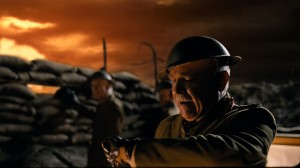
fxg: What were some of the considerations you had going in to those discussions?
Roberts: I had a sneaking suspicion that we would be more involved than first thought, so we managed to convince production to put some time aside to shoot elements on a ‘just in case’ basis. They had a great pyrotechnics department. My experience is that they are always keen to help and are always keen to let off a few extra explosions for you. And you can never have too much – the more elements you’ve got the more likely you are able to solve problems later. Anything that starts to take a long time on set starts to be a financial problem and invariably it will become a ‘fix it in post’ solution. Some of the practical effects they thought they’d get on the day weren’t achievable, and some of the practical effects seen in context needed to be exaggerated or augmenting.
fxg: Can you talk about some of the smoke and rain enhancements Cutting Edge contributed?
Roberts: Well, there’s a whole lot of crawling around in the dark in the mud and dirt and that was done over a few nights and in order to make it feel like it’s in warfare, they decided to shoot with a fair bit of smoke. What happens in Townsville, Queensland, where the film was shot, is that at night quite a bit of breeze will come up. So unfortunately they just couldn’t keep those smoke levels consistent. At the end of the day in the edit you end up with a lot of shots where you cut from someone to someone else – there’s smoke in one shot but you cut back and there’s no smoke. So we had to just literally adjust the smoke levels. We cut out the midground and foreground and put smoke in. We went and shot smoke and rain plates to deal with that work. When they’re in the trenches, just the reality of lighting in those situations makes the rain invisible. So we added rain in the foreground sometimes and smoke in the background.
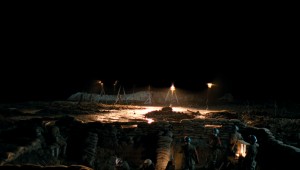
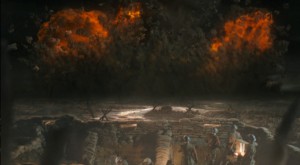
fxg: Was there some other environment work involved for the trench shots?
Roberts: Yes, because those trench shots were filmed primarily in the daytime, in bright Queensland sun, what happened was they had a number of large scrims they’d wheel in over the top of each section as they got to it, but they couldn’t cover everything. So as you looked out you’d see a brighter world and we literally graded down the background and threw rain and smoke over it to make it look bleak. That involved roto’ing the foreground, pulling keyes on the background and inserting in the elements to make it all work. The big trick is to have something for each distance, so you’ve got midground, background and foreground rain to get that misty quality in the background. We also had smoke at different scales. We shot the smoke against black – we did this about 10 o’clock at night and pointed the camera towards a place that didn’t have any city lights, which wasn’t too hard in Townsville. You use night as your black, and light it from the front. For rain you generally try to back-light it to get nice glints off it, otherwise you don’t really see it. Also, when they were shooting in all the tunnels, which were actually all sets, they tried to light the whole thing as practically as possible to add to the claustrophobic feeling. Strange things happen to lights at those low levels – you get lens flares off candles which could be quite distracting, so we would remove those flares.
fxg: What kind of matte painting shots were there?
Roberts: We were shooting on a field that had been ploughed and had trenches dug into it but it was surrounded by gum trees and a clear blue sky. So every shot you see that’s out to the expanse – we’ve been in there. The football match that happens in the film involved adding smoke behind the players. The same for the scenes unloading the trucks where there’s bombardment happening behind them. In that case you can see the whole environment. That whole background is a matte painting with some 3D elements like smoke in the distance. Also, when we first see Queensland, we see the hero ride up on his horse and survey the distance and you can see the mining town and a river winding through the scene. Everything beyond him is a matte painting. At the end when the explosions are approaching, there’s a big wide shot where you see the ridge running off into the distance, that’s a totally synthetic shot – a matte painting with a lot of 3D explosions elements. You project the matte painting onto a geometry surface and add a whole pile of 3D elements and re-light the scene.
fxg: Can you talk about the major explosions shots towards the end of the film?
Roberts: In the big explosion, everything is 3D and was predominantly produced in Houdini. At the beginning, they had the support of the local mining community, who were very helpful. The idea was that the explosion had to be the biggest thing that ever happened before the atom bomb went off. About mid-way through the film, we talked about whether the mining community could do a huge explosions and we gave them reference. Everyone looked at the reference I had and went ‘Well, no we can’t do that’. On the day before the shoot, I went out with the second unit. They blew the top off a hill, but compared to what we wanted it was surprisingly insignificant. That’s when we realised we had to do it digitally rather than relying on a practical explosion or compositing practical elements.
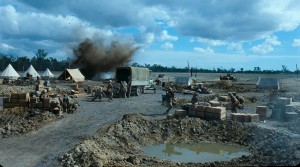
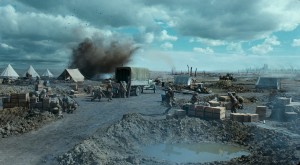
fxg: What kind of technical approach did you take?
Roberts: First I did some very rough previs. Then I supervised that shoot so I knew what cameras we had used. Then we did another previs the minute we had the foreground plates so they had something to edit with. Through that we were able to work out what we were going to see in the film. From there on we made the final shot with 12 frame handles. Our previs was very complete. It gave you the timing of the explosion, the timing of things going up, how long it would take for things to fill the frame. There’s a sound shockwave that comes forward that hits the camera and then a big dust cloud. The next stop involved working in Houdini. It’s our tool of choice for anything physical effects based. Dave Brown, our head Houdini guy, pretty much achieved the vast majority on his own. We made some of the elements for the sound shockwave in Maya. Tom King did those elements. The only real elements in that shot are the sandbags that form the front of the trench. We composited it all in Shake.
